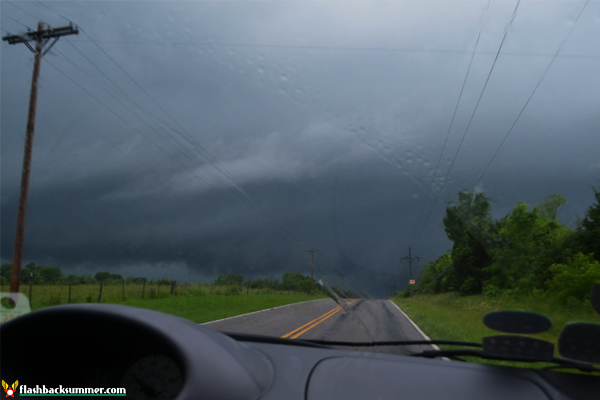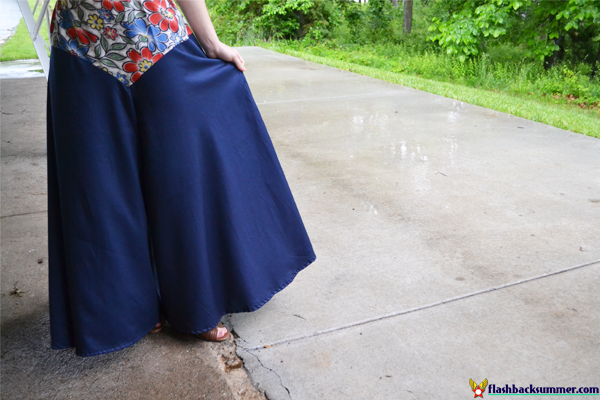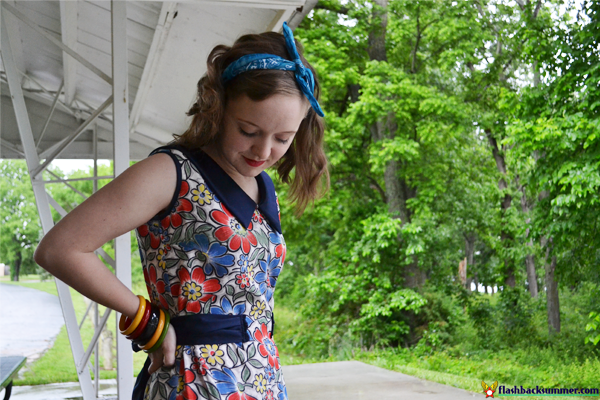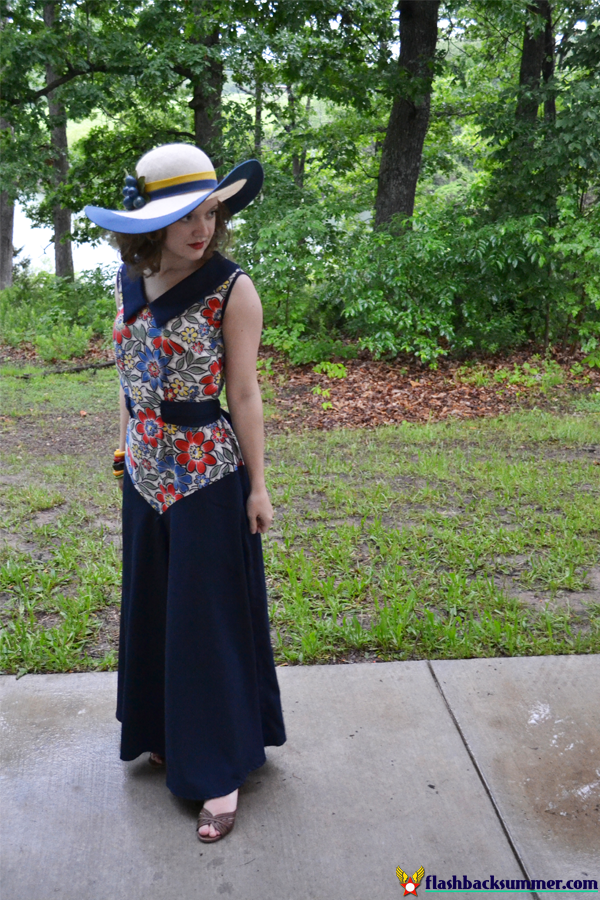I haven't posted in the past few days because I've been gearing up for this one! I don't think I've ever been so excited about a controversial post.
Today we have a panel of lovely vintage ladies that are here to talk about a tough issue: Why is the vintage community made up of mostly white people?
Now before anyone puts up the defenses, this isn't going to be a guilt trip or accusation party for any of you, so don't worry. This post has come from my own wonderings about how mostly white people gravitate toward vintage and why that is, and I've enlisted the help of women who are willing to share their unique perspectives and personal experiences on why this might be. I'm a firm believer that personal relationships and listening to each other's stories are two of the biggest keys to achieving racial equality in our world!
I've also noticed that I have sometimes unintentionally thwarted efforts to meet that goal. As a white person, it can be very scary to talk about racial issues in our society today. I don't want to say something dumb or insensitive and get labeled an ignorant racist. I don't want to hurt people's feelings. I don't want to become a hated hashtag! However, I do want to help. But I'm not always sure how I can help. I know society has been skewed in my favor and that I probably do things to propitiate that, but I don't know exactly how I'm doing it, and I don't know how to fix it. It can be frightening to ask, though.
From what I've heard, it can be frightening to talk about these issues as a member of a minority race, too. It takes courage to call out a society that doesn't always value you. It can be hard to be bold and take flak from people who don't understand your experience and who don't seem to want to understand. It takes strength to intentionally bring up a subject that you know is going to rock the boat. It can be hard to stand up in the face of stereotypes knowing that many people will assume who you are instead of listening to who you are, assuming they know your motivations already instead of discovering them.
This is going to be a long post, but I think it's an important one. The goal is to find out how we as members of the vintage community can work together to support each other in a difficult world and how we can make our niche more accepting of all races.
OKAY, LET'S GET STARTED!
Meet the panel!
Carla - blogger at "Tiny Angry Crafts" | Nora - blogger at "Nora Finds" | Daffny - blogger at "A Vintage Nerd" | Angelique Noire - pinup model | Candace - pinup model
What initially drew you to vintage style and the community around it?
Daffny: I have always been attracted to things from the past and I always loved history. I'm intrigued by how people live and was very close on becoming an Anthropology major at University. As a young girl I also spent a great deal of time with my grandma who introduced me to classic film and old fashioned living.
Angelique: I was drawn to the vintage style since childhood. My father constantly played Jazz music, and I regularly watched Classic movies. Naturally seeing the beautiful Old Hollywood actresses, I wanted to imitate their styles. I initially wanted to start modeling early on because I hoped to be made to look like those Old Hollywood actress. Little did I know, that being a Black woman, hindered my likelihood in being booked to do commercial print work in that style… As a result of being fed up with not being able to find many pictures of Black women shown in those styles I adore, I decided to share my passion via the Internet. When I did this, I discovered the vintage community that existed.
Carla: I initially was drawn to vintage from watching classic films with my grandpa. As I got older, I found out people dressed in those styles, and I wanted to play too.
Nora: What drew me to the vintage style are the elegance, the femininity, and the nature of vintage - where every pieces have their own story and we all find different treasures. Honestly the community didn't matter to me at first and it still doesn't. For me this is just the way I express myself but it doesn't dictate who I am. I don't limit myself to hang out with vintage kids only :)
Candace: Two words: Marilyn Monroe. When I got into Marilyn, about ten years ago I was surprised that what she wore could still be worn today, a lot of her dresses were very slimming and didn't look dated, the same can be said for Audrey Hepburn. The fashion is what drew me in first, and then the cars, and of course the men and everything fell into place there. I love the vintage style.
Did you feel immediately welcomed into the community, or were there some barriers you encountered, or even still deal with? How do you cope?
Nora: Yes I definitely felt welcomed. There are always snotty people or cliques but I didn't feel like it's any different from any community. The main challenge are people who decide that they are more "vintage" than others, which sometimes translate to rude racial comments - I had a vintage seller complaining about her customer, "I don't get why Chinese people dress so badly - they just don't get how to wear vintage."
Angelique: Being that I am a professional model, it was pretty easy to share nice pics online to use as bait. ;) My overall experiences have been pretty positive while participating in the vintage community…Often times I am praised by people of various races, so I feel as welcomed as anyone would.
If what I seek to find are barriers within the 1920s-60s style lovers, then it is easy to see these barriers. Yes, I have witnessed followers/admirers tag their friend on my photos only to have the tagged friend respond in ways that show they had no desire to appreciate Black women. Yes, I have witnessed photographers who's body of work fail to show Black models, or they choose to include a few photos of the one "ethnically ambiguous" model they have photographed. Yes, I see retro clothing brands that don't use any Black models to model their clothing...Yes, I see pinup magazines that have yet to have a Black model on their cover.
All in all, I don't expect everyone to love me, especially if they fail to see beauty when it is displayed with brown skin. I can't totally fault them because the beauty icons of the 1920s-early 1960s era were mainly Caucasian or Caucasian looking. Rarely if ever were mainstream magazines, movies, print ads, etc. showcasing Black women as being beautiful...especially dark skinned Black women. When a person is constantly being subconsciously programmed by all forms of media that the Caucasian person was the beauty standard of that time, then vintage lovers of today will naturally gravitate toward going crazy over the blonde, brunette, or redhead pinups more than they would a Black Pinup. For those in the vintage community who have broadened their appreciation for fellow vintage lovers of various ethnicities, those people are the ones from whom I feel appreciation.
Candace: I was quite surprised that it was very accepting; I thought I would be seen as weird or strange, that a black girl loves Marilyn Monroe and love classic Hollywood movies and lifestyle as much as white people do. Where I came from that wasn’t cool, when I started to get into the pinup/vintage/retro culture a lot of black people looked at me crazy and said I was trying to “act white” or “be white” so I would try to hide it so I wouldn’t feel alienated. That didn’t work out too well because when I talk on a subject that I love watch out I can go on about it for years! Haha!
Carla: After I stopped being scared, and started to talk about vintage sewing and the like on my blog, I felt very welcomed. I was initially terrified because I didn't see anyone who looked like me in the blogging world, who would regularly blog. But, I shrugged it off, and just went on and did my own thing.
Do you have to overcome barriers or stereotypes from people outside the vintage community as you rock vintage style? Have you gotten flak from others in your racial group that don't wear vintage?
Candace: Oh my goodness yes! Like I said the vintage/retro/pinup community has been very welcoming but anyone outside that is a pain to deal with. Especially, from my race (African-American), it’s the most difficult thing because it’s not a cool or popular thing. They always bring race into it, and I know that there was segregation but we can’t change the past. I can’t help it that Gregory Peck was a great actor and Lucille Ball makes me laugh. I just see talent, I know of the racial problems, but that’s not the first thing I look at. Unfortunately, there are a lot of narrow-minded people out there that if you don’t like anything that’s black if you’re black, you’re abandoning your people and forgetting your roots and are trying to be white. Never mind the fact that I have a business of black pinups promoting black women and talking about black history of female entertainers.
Nora: Just as anyone who's adopting a new fashion style I did get some comments like, "You're very dressed up," but no one has ever been rude or anything. I haven't gotten any negative comments too from my racial group, mostly just comments like, "I don't know how to start wearing vintage," or, "Ijust don't think it'll look good on me!"
Carla: Well, usually if I'm all dolled up and am wearing a hat, I get asked if I'm on my way to church. I had someone call me Aunt Jemima when I was rocking one of my hair scarves on the bus. I flipped him off, and he said nothing the rest of the ride.
In my own racial group, I've gotten "Why do you want to dress like a white girl?" a lot.
Aside from that, I just get the usual 'Oh I wish people dressed up more' from older folks, and people being super polite to me.
Angelique: For the most part, I have received an abundance of appreciation from many different women. I have yet to see comments or hear someone ridicule my physical appearance. I guess I am lucky. On many occasions, I have heard and read negative comments about several popular pinups in the vintage community.
...In spite of how easy it is for pinup magazines to get women to submit their pinup style pics without compensating them for their efforts, there are still pinup magazines that have yet to put Black Pinups on their covers. In the pinup world, any female can be an "internationally published" model because all it takes is sending your pictures to the various magazines, which is very different from what I'm accustomed to as a mainstream model. So it is a lack of effort on the magazines part to not publish a Black woman on their cover. Just like it is a lack of effort for Repro companies to lack showing diversity in the models they use...and I am not referring to the diversity of hair color or tattoo vs non-tattooed Caucasian pinups.
Daffny: You may be surprised by this but here in New York not much shocks or surprises people unless you are wearing very sexy or revealing clothing. If you do dress that way then yes, you will get a lot of stares and comments being made. I, on the other hand, have never encountered any flak from anyone within my culture or from strangers. I am usually with my family and people stare at me more because they see me with three small children or because of my leg braces. I have often received lovely comments from strangers, both men and women. I have found more men seem to appreciate the vintage look and are not shy about saying how much they like my look. I think older gentlemen appreciate it it when a woman dresses like an old fashioned lady. I know some people find the word Lady and the phrase "Lady-like" to be a bad thing but I love it and I very much consider myself a lady.
What have been your observations on who the vintage community holds up as the "ideal" beauty type (if there seems to be one)? Where does this ideal come from, and what effect do you think this has on the community?
Carla: I was actually talking about this with a friend the other day. This whole slightly scary obsession with 'being pale' in the vintage world is something that I've seen a lot. This is amusing, as during the mid-century there were a plethora of sun tanning lotions, and concoctions to give that "sun-kissed" look. I think with Dita and the revival of vintage fashion/burlesque, people have set her as the ideal modern vintage woman, which shows in a lot of things.
Angelique: As demonstrated during the 1940s and 50s the "beauty ideal" was a Caucasian woman, which naturally the vintage community and modern media's version of this era continues to perpetuate. In addition, plastic surgery, chemical facial enhancements, and/or the trend of body tattooing are also common factors we see displayed by most of the popular pinup models. It shows that the quest for "perfection" (as demonstrated in modern society), also influences vintage lovers even though these enhancements were considered very taboo during the 40s and 50s.
Nora: The ideal beauty type for me seems to be long luscious hair, luscious lips, small waist. I observe that this standard is the same across races but I definitely think these three features are the favorites.
Daffny: The vintage community seems to be comprised many different categories of vintage… At the end of the day no matter how they dress, these folks love vintage. I have found through observation that the extremes of those in the community are the ones who seems to get the most attention. The purest [head-to-toe vintage] and the unconventional. If I were to choose which is the most popular at the moment I would have to say the unconventional. I think for a long time the ideal look was the pale skin and ruby red lips and perfect victory rolls. Now it seems people want to see either those who dress exactly like a specific decade or those who take it to another level and add pink hair to the mix. I think its made the community more diverse but its also confused those wondering if this person is a part of community and perhaps confuses bloggers who wonder if they are indeed a vintage blogger or not.
Candace: When I first entered this vintage community, I knew Marilyn was the most beloved, worshipped woman in it, her and Bettie Page, at first I couldn’t see what the big deal was until I watched a movie of Marilyn (Don’t Bother to Knock-1952) and was mesmerized by her. I saw a lot of hour glass models and thought I had to be 5’9 and skinny to be a model. Thanks to Facebook I have seen a growth in pinup and was pleasantly surprised that the vintage community accepts all looks, body types, age, etc. I don’t think that there is an effect on the community for an ideal body type unless we put it on ourselves. That’s the great thing about pinup, the modeling world has a specific type but in the pinup world it’s anyone is welcome, which is why my slogan is “Embrace your inner pinup!”
Do you feel there is anything missing in the content of vintage books/blogs/resources that would be helpful to you as a person of color? Is there a subject you wish more people would talk about?
Carla: Oh yeah, there are a great deal of resources I feel are missing; hair, makeup, 'how to dress' guides, etc. But I think I can try to make them available from my own experience. Because someone with naturally curly hair, who straightens it with heat can't just do wet rag curls, I would have a 'fro. But, in regards to things in vintage books, it's very rare something from the past purposefully was created to cater to PoC. They existed, such as a hair styling book by Madame CJ Walker, but they are difficult to find.
Daffny: Although I do consider myself a person of color, my color happens to be white. People often get confused when I tell them I am Latina but in fact Latinos come in all colors. I think the only thing missing is that people assume all Latinos are Mexican, even in the vintage community because either that's all they know or all they see within the community. In fact there are all sorts of Latinos out there.
Candace: I wish there was more history instead of books only pertaining to pinups of color. I have a lot of pinup magazines and I just wish there was a good mixture of all ethnicities, instead of one dominating race dominating the other. I had to create Black Pinups because I didn’t know there were black pinups and it was so underground. I wish that there was more integration. I know that it’s not out of spite or evil, but I also think people just don’t know and some are oblivious to it. I can’t tell you how many people more so from my race are surprised to find black pinups. But I think there is progress; I am seeing quite a few black pinups in modern pinup publication. I think everything will change for the better.
Nora: I don't think it's particularly "missing" - I don't feel like styling vintage is that different just because I have straight hair/small eyes/yellow skin. I don't think the resources are missing - I mean it's fair enough that there are less resources on how to wear and style vintage cheongsams, but there aren't many Asian vintage writers out there. The white writers probably feel like it's not their expertise so they wouldn't touch on that subject.
Tune in tomorrow for Part 2 of this controversial post!
But until then... Are there any of these ladies' comments that really resonate with your experience? Are there any opinions that you don't quite agree with? Why is that?
As usual, please keep your comments dignified and respectful!
For more information on Asian culture and vintage, check out Nora's post "Why Don't Asians Wear Vintage?"























































